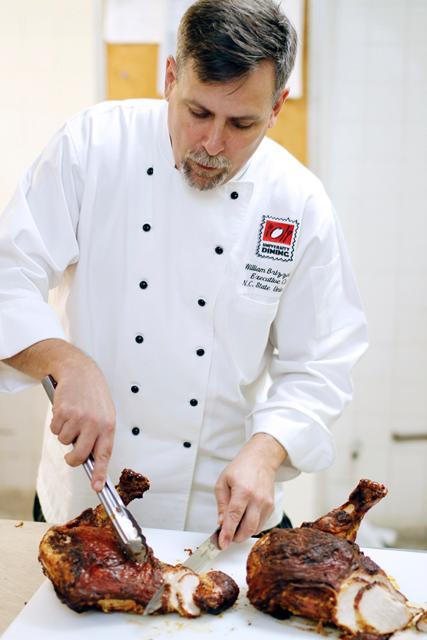
© NCSU Student Media 2011
Executive Chief of NC State University, Bill Brizzolara works in the kitchen on the fourth floor of Tally, preparing two turkeys with herb seasoning for a catered event. Photo by Oliver Sholder
The dining halls on N.C . State’s campus are filled with students each and every day. But what goes on behind the scenes remains a mystery to most.
“I eat at Fountain dining hall almost every day,” Nasser Koucheki , a sophomore in biological sciences, said. ”A lot of students eat there so it can definitely get crowded. I don’t really know what goes into making the dining hall run smoothly— I’ve never thought about it. It’s probably not the easiest job.”
It may not be the easiest, but it is William Brizzolara’s job. He is the executive chef of University Dining at N.C . State. Brizzolara began cooking in high school and continued in college. A chef he was working for saw talent in Brizzolara and encouraged him to attend culinary school. After culinary school, he worked as a chef in numerous restaurants. He started off assisting the University with VIP catering events on a part time basis and was offered the position after a few events.
“I enjoy the creativity that comes with the job,” Brizzolara said. ”I’m always challenged in so many ways, whether it is menus, staffing, equipment or just keeping up with the ever increasing food trends.”
Much thought and deliberation goes into creating the menus for the dining halls.
“It is a collaborative process that includes ideas, equipment capacity, cost and availability of food items,” Brizzolara said. ”We take ideas from several sources. We seek feedback from students in several ways from surveys to our social media sites.”
Brizzolara said he keeps up on trends through conferences and professional publications. Once he has a master list of items he would like to run on the menu he evaluates it to see what areas he might need to improve.
He calls this process piecing puzzles.
“Each meal we must consider balance between highly accepted entrees, new items, ethnic items, healthy choices and piece them together in a way that is cost efficient and does not exceed our equipment capacity.”
Even a single recipe demands thorough consideration.
“First we evaluate and update our menu list to reflect student comments, current trends and new products on the marketplace,” Brizzolara said. “From there, we identify needs and wants in our menus. This helps us to focus what types of new recipes we need.”
According to the chef , researching ideas and sourcing food products for that recipe takes up a large part of designing a menu. Rough draft recipes are also reviewed for nutritional values and cost.
“Once that process is complete, the recipe is then ready to be tested and tasted by several people,” Brizzolara said. “If it passes the taste test it is entered into our system. If not we retest it or scrap the idea.”
Wings, pizza, pasta, burgers, omelets, fried chicken, macaroni and cheese and chicken tenders top the list of students’ favorite foods.
“I tend to eat the same thing a lot,” Koucheki said. “It’s a lot of chicken tenders and macaroni and cheese because I like them.”
The collegiate dining scene may still contain classic staples like burgers and pizza, but it has also evolved to include many more types of cuisines and ethnic food experiences than in the past.
“The world has grown smaller in terms of culinary experiences,” Brizzolara said. ”Students have been exposed to more different types of food than in the past. They are much more knowledgeable about healthy eating and the dangers of obesity. What was once weird and strange a few years back is commonplace today. More and more students are either asking for or willing to try different types of food.”
Brizzolara said he doesn’t think the dining halls’ yogurt bars, gyro bars or dumpling bars would have been as popular 10 years ago as they are today.
“However, everyone is still always going to want food they can recognize so we still see a big demand for comfort food,” Brizzolara said.
The dining halls offer students the best of both worlds—healthier, more diverse options along side comfort food mainstays.
“I eat at Clark dining hall occasionally,” Tom Dean, a sophomore in political science, said. “One day I might want to eat something familiar like a burger, but sometimes I’m up for trying a new dish that I’ve never ate before. It’s nice to have options.”